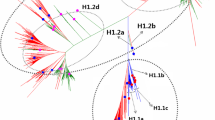Abstract
Phylogenetic methods have been widely used to detect the evolution of influenza viruses. However, previous phylogenetic studies of influenza viruses do not make full use of the genetic information at the protein level and therefore cannot distinguish the subtle differences among viral genes. Proteoty** is a new approach to study influenza virus evolution. It aimed at mining the potential genetic information of the viral gene at the protein level by visualizing unique amino acid signatures (proteotypes). Neuraminidase gene fragments of some H5N1 avian influenza viruses were used as an example to illustrate how the proteoty** method worked. Bayesian analysis confirmed that the NA gene tree was mainly divided into three lineages. The NA proteotype analysis further suggested there might be multiple proteotypes within these three lineages and even within single genotypes. At the same time, some proteotypes might even involve more than one genotype. In particular, it also discovered some amino acids of viruses of some genotypes might co-reassort. All these results proved this approach could provide additional information in contrast to results from standard phylogenetic tree analysis.
Similar content being viewed by others
References
Choi Y K, Ozaki H, Webby R J, et al. 2004. Continuing Evolution of H9N2 Influenza Viruses in Southern China. J Virol, 78: 8609–8614.
Cummings J L. 2003. Toward a molecular neuropsychiatry of neurodegenerative diseases. Ann Neurol, 54(2): 147–154.
Cummings J L. 2004. Dementia with Lewy Bodies: Molecular Pathogenesis and Implications for Classification. J Geriatr Psychiatry Neurol, 17(3): 112–119.
Guan Y, Peiris J S M, Lipatov A S, et al. 2002. Emergence of multiple genotypes of H5N1 avian influenza viruses in Hong Kong SAR. Proc Natl Acad Sci USA, 99: 8950–8955.
Guan Y, Poon L L M, Cheung C Y, et al. 2004. H5N1 influenza: A protean pandemic threat. Proc Natl Acad SciUSA, 101: 8156–8161.
Holmes E C, Ghedin E, Miller N, et al. 2005. Whole-genome analysis of human influenza A virus reveals multiple persistent lineages and Reassortment among Recent H3N2 Viruses. Plos Biology, 3: 1579–1589.
Hatta M, Gao P, Halfmann P, et al. 2001. Molecular basis for high virulence of Hong Kong H5N1 influenza A viruses. Science, 293: 1840–1842.
Huang K, Fan X H. 2005. Molecular Epidemiological Studies on H5N1 Influenza Viruses from Poultry in Nanning (Mr. thesis).: Guangxi Medical University, Guangxi, China. (in Chinese)
Iwatsuki-Horimoto K, Kanazawa R, Sugii S, et al. 2004. The index influenza A virus subtype h5n1 isolated from a human in 1997 differs in its receptor-binding properties from a virulent avian influenza virus. J Gen Virol, 85: 1001–1005.
Kou Z, Lei F M, Yu J, et al. 2005. New genotype of avian influenza H5N1 viruses isolated from tree sparrows in China. J Virol, 79: 15460–15466.
Kumar S, Tamura K, Nei M. 2004. MEGA3: Integrated software for Molecular Evolutionary Genetics Analysis and sequence alignment. Brief Bioinform, 5: 150–163.
Li K S, Guan Y, Wang J, et al. 2004. Genesis of a highly pathogenic and potentially pandemic H5N1 influenza virus in eastern Asia. Nature, 430: 209–213.
Lutskiy M I, Rosen F S, Remold-O’Donnell E. 2005. Genotype-Proteotype Linkage in the Wiskott-Aldrich Syndrome. J Immunol, 175: 1329–1336.
Matrosovich M N, Krauss S, Webster R G. 2001. H9N2 influenza A viruses from poultry in Asia have human virus-like receptor specificity. Virology, 281: 156–162.
Matrosovich M, Zhou N N, Kawaoka Y, et al. 1999. The surface glycoproteins of H5 influenza viruses isolated from humans, chickens, and wild aquatic birds have distinguishable properties. J Virol, 73: 1146–1155.
Obenauer J C, Denson J, Mehta P K, et al. 2006. Large-scale sequence analysis of avian influenza isolates. Science, 311(5767): 1576–1580.
Rodriguez C, Quero C, Dominguez A, et al. 2006. Proteoty** of human haptoglobin by MALDI-TOF profiling: Phenotype distribution in a population of toxic oil syndrome patients. Proteomics, 6(Suppl 1): S272–S281.
Ronquist F, Huelsenbeck J P. 2003. MrBayes 3: Bayesian phylogenetic inference under mixed models. Bioinformatics, 19: 1572–1574.
Roth M J, Forbes A J, Boyne II M T, et al. 2005. Precise and Parallel Characterization of Coding Polymorphisms, Alternative Splicing and Modifications in Human Proteins by Mass Spectrometry. Mol Cell Proteomics, 4(7): 1002–1008.
Shillingford J M, Miyoshi K, Robinson G W, et al. 2003. Proteoty** of Mammary Tissue from Transgenic and Gene Knockout Mice with Immunohistochemical Markers: a Tool To Define Developmental Lesions. J Histochem Cytochem, 51(5): 555–565.
Simmons M P, Ochoterena H. 2000. Gaps as Characters in Sequence-Based Phylogenetic Analyses. Syst Biol, 49(2): 369–381.
Thompson J D, Gibson T J, Plewniak F, et al. 1997. The CLUSTAL_X windows interface: flexible strategies for multiple sequence alignment aided by quality analysis tools. Nucl Acids Res, 25: 4876–4882.
Wang J, Li K S. 2004. Genotype Evolution of the H5N1 Influenza Viruses in Aquatic Birds in Southern China (Mr. thesis). Shantou University, Guangdong, China. (in Chinese)
Webster R G, Bean W J, Gorman O T, et al. 1992. Evolution and ecology of influenza A viruses. Microbiol Rev, 56: 152–179.
Zhuang Z P, Huang S, Kowalak J A, et al. 2006. From tissue phenotype to proteotype: Sensitive protein identification in microdissected tumor tissue. Int J Oncol, 28(1): 103–110.
Author information
Authors and Affiliations
Corresponding author
Additional information
Foundation items: National Nature Science Funds (30670242, 30500056)
Rights and permissions
About this article
Cite this article
Shi, Wf., Zhang, Z., Peng, L. et al. Proteoty**: A new approach studying influenza virus evolution at the protein level. Virol. Sin. 22, 405–411 (2007). https://doi.org/10.1007/s12250-007-0039-7
Received:
Accepted:
Published:
Issue Date:
DOI: https://doi.org/10.1007/s12250-007-0039-7




